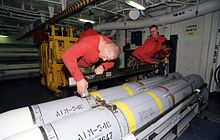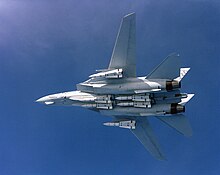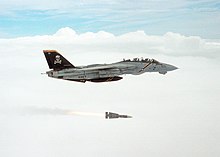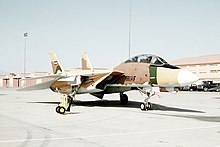AIM-54 Phoenix
| AIM-54 Phoenix | |
|---|---|
|
|
|
| General Information | |
| Type | Air-to-air missile |
| NATO designation | AIM-54 Phoenix |
| Country of origin |
|
| Manufacturer | Hughes Aircraft Company , Raytheon |
| development | 1960 |
| Commissioning | 1974 |
| Working time | 1974-2004 |
| Unit price | $ 477,000-1,000,000 |
| Technical specifications | |
| length | 3960 mm |
| diameter | 381 mm |
| Combat weight | 463 kg |
| span | 914 mm |
| drive | Solid rocket |
| speed | Do 5 |
| Range | +185 km |
| Service ceiling | 30,000 m |
| Furnishing | |
| steering | Inertial Navigation & Data Link |
| Target location | active radar target search or SARH |
| Warhead | 60.75 kg continuous rod |
| Detonator | Impact Detonator & Radar - Proximity Detonator |
| Weapon platforms | Grumman F-14 Tomcat |
| Lists on the subject | |
The AIM-54 Phoenix , named after the mythical phoenix bird , is a long-range air-to-air missile for the United States Navy . The US Navy decommissioned the missiles used from 1974 in 2004. The semi-active / active radar-guided missile is one of the longest-range air-to-air missiles in the world and can only be fired from the AN / AWG-9 fire control system , which is particularly present in the Grumman F-14 Tomcat . The main target was bomber formations during the Cold War . Besides the US Navy, only the air forces of Iran used the weapon, nothing is known about the current operational status there.
The Phoenix was improved several times during its service life, there were a total of three versions known as AIM-54A , AIM-54C and AIM-54C ECCM / Sealed . The unit price was over a million US dollars.
technology
A phoenix is 3.96 meters long and 38.1 centimeters in diameter. The largest wingspan of the wings and fins, which grow larger towards the rear, is 91.4 centimeters. The rocket has four of these wings in a delta shape to stabilize the flight path and four fins at the very rear for control. The A version weighed 454 kilograms, the C weighed 463 to 472 kilograms, depending on the equipment, the C ECCM / Sealed 464 kilograms.
The missile is structured as follows: The radar device is located under the nose cone, behind it the target control and then the warhead . These three sections take up a good half of the rocket. The rear half consists mainly of the fuel and the rocket engine. The automatic control system is at the rear end of the rocket. The wings begin just before the end of the warhead. The individual sections are marked on the outside of the rocket by colored stripes (yellow for the warhead, orange for the engine).
The AIM-54 has its own on- board radar with which it can capture and track its target. The missile can use three different positioning systems to approach targets at great distances. Standard is an inertial navigation system that lets you fly to a point selected by the AN / AWG-9 , where the targets are then to be located. Alternatively, active or semi-active radar control is used. With the latter, the Tomcat flies further towards the target and illuminates it with its radar, so that the Phoenix can find the target using the reflected radar beam. In the final approach, from a distance of approx. 20 km, the weapon uses its own radar, regardless of the operating mode, in order to detect and steer towards the target. Starting in “fire-and-forget” mode (active radar control) offers certain advantages over semi-active mode. With this "fire-and-forget-them" setting, the rocket continuously takes aim at its target so that the F-14 can turn off immediately after the weapon has been launched. The disadvantage of this mode is that compared to the AWG-9 , the Phoenix's on-board radar is smaller, weaker and easier to disrupt .
The weapon was specially designed for simultaneous starts. The Tomcat's on- board radar was able to provide target information to all six Phoenix at the same time. The missile's radar made it possible to attack widely spaced targets simultaneously.
A Phoenix has a high-explosive warhead weighing 60.75 kilograms, which is filled with the explosive PBXN-106 and detonated by means of an impact or proximity detonator and thus “shoots” rocket fragments at the target even if it is not hit directly destroy or seriously damage it.
It is powered by a rocket engine that uses solid propellant . This means that the rocket reaches speeds that are officially stated by the US Navy as “In excess of 3,000 mph (4,800 kmph)”, ie “over 4,800 kilometers per hour”. The range is specified as "over 100 nautical miles (185 kilometers)".
history
Development history
The first ambitions of the US Navy to develop a long-range missile arose as early as the 1950s. At that time, the US Navy commissioned Bendix to plan the AAM-N-10 Eagle . This should be used on the Douglas F6D Missileer . After doubts about the concept of the hunter, both programs were stopped at the end of 1960. Shortly thereafter, the US Navy took up the idea for a still unnamed long-range weapon AAM-N-11 . At the end of 1962, the order for the missile went to Hughes Aircraft , which built the new missile on its old AIM-4 Falcon short-range missile . In addition to the results from Bendix, Hughes was able to incorporate the experience from the AIM-47 Falcon program into the development, a long-range missile for the United States Air Force from the 1950s , which was also never completed . In February 1963, the AAM-N-11 was given the nickname Phoenix , and in June, as part of a global reclassification of all missile types, it was renamed the AIM-54 .
The original plan was to use the Phoenix on the General Dynamics F-111B , a fighter version of the United States Air Force's F-111A, which was actually classified as a fighter-bomber , wanted by the US Navy .
The first test flights of the XAIM-54A , the prototype of the new rocket, began in 1965. On September 8, 1966, the first complete test of all functions of a Phoenix took place on board a Douglas NA-3A Skywarior . This took place over the Navy Pacific Missile Range near the island of San Nicolas off California . The missile caught a drone and successfully intercepted it. In 1967 the first F-111B pre-production models were launched.
In 1968, the idea of the F-111B was put aside because the aircraft was found to be overweight and underpowered for use on aircraft carriers ; the short range was also criticized. Instead, the entire development is now giving up specifically for that was Phoenix -designed radar of type AN / AWG-9 in the new 14 F-Grumman Tomcat installed, the role of the F-111B was to take over. In spite of this, the tests initially continued with the F-111B operational , and in 1969 the Phoenix took off for the first time . By May 1970, 29 rockets had been fired, 22 of which were able to achieve kills.
On April 28, 1972, the first AIM-54 were tested from the Tomcat , and in November of that year several missiles were launched from an F-14 against several targets for the first time . In December, an aircraft fired four missiles at five targets, one of which scored a direct hit, and the others together destroyed three drones with proximity detonation.
The first AIM-54A missiles were delivered to the US Navy in 1973. In June, a Phoenix set a world record when it shot down a BQM-34E Firebee drone from a distance of 110 miles. Of the 56 missiles launched so far, 43 scored a hit. The first complete system test from an F-14 took place on November 21 of that year . Within 38 seconds, the pilot fired six Phoenix at six individual targets 50 nautical miles away, four of which were hit and another damaged. This was the only time in the history of the Phoenix that six missiles were fired quasi-simultaneously from an aircraft.
The following year the AIM-54 was embarked on the USS Enterprise (CVN-65) with squadrons VF-1 Wolfpack and VF-2 Bounty Hunters .
Versions
The first version of the Phoenix , the AIM-54A , was declared operational in 1974. It was the basic version that has been improved several times over the years. The AIM-54B was supposed to make building the weapon easier and cheaper, but it was never produced and never appeared in the inventory of the US Navy under this name. In the case of the B , the fins, which were shaped in a honeycomb structure in the case of the A , were replaced by simpler sheet metal.
The first real further development of the Phoenix began in 1977 . In the AIM-54C , analog components in the target search and flight control have been replaced by digital ones. An improved engine increased speed and range, and the target acquisition against small and low-flying objects as well as the electronic protective measures were improved. The first of initially 15 prototypes was delivered in August 1979. In 1981 the first launch of a C took place against a target 70 miles away, which tried to deflect the missile by means of electronic warfare , which did not succeed. The C version was finally produced from 1982 and reached operational status two years later. While the C was still in production , the warhead of the initial version was exchanged for a 20 to 25% more effective one.
In 1988 a further improved version was introduced, which was called AIM-54C Phoenix ECCM / Sealed or more simply AIM-54C + in the US Navy . In addition to further improved ECCM this version required during the flight also no heat exchange fluid from the aircraft (which is why the description sealed , so sealed been added). In addition, some computer chips were swapped for faster versions. It was possible to upgrade from C versions to C + . The first flights with the version took place in 1990.
There were training versions of both the A and the C version. These were called ATM-54 (version to be launched with an inactive warhead), CATM-54 (version for target acquisition training, was not started after acquisition, but remained on the aircraft) and the AEM-54 (version with special electronics for performance evaluation). The DATM-54 for training ground crews only existed in the A version. The reason was that the handling of weapons on the ground hadn't changed as a result of the improvements.
A total of around 5000 AIM-54 were produced, of which around 50% were the AIM-54C and C + versions . The cost for version A was $ 477,131, the later versions cost more than $ 1 million at the end of production according to various sources, some even speak of two million.
operator
Besides the United States Navy, there was only one other user of the Phoenix . The reasons for this were the price, the size as well as the fact that the AN / AWG-9 fire control system was required to use the missile. Only Iran, under the US-backed Shah Mohammad Reza Pahlavi , acquired the carrier aircraft and the weapon at the same time. In 1972 the contract for the sale of 714 AIM-54A was signed. By May 1979, when the Islamic Revolution broke out in Iran, 248 rockets had been delivered, so that the new ruler, Ayatollah Ruhollah Khomeini , now had weapons and aircraft made by the then most modern American production after his coup.
Last years and retirement
From 1989 the rocket was no longer produced by Hughes Aircraft ( known as GM Hughes Electronics after the division was sold to General Motors in 1985 ), but was partly produced by Raytheon and was also officially designated as the Raytheon AIM-54C Phoenix in the US Navy .
As early as 1992 it was decided that the planned next generation of long-range missiles, the so-called AIM-152 Advanced Air-to-Air Missile (German: " Advanced Air-to-Air Missile "), would be deleted from the budget without replacement and not developed. In September of that year, the last Phoenix was also commissioned by the US Navy, which was manufactured in 1993.
In February 2002 it was decided to decommission the missile from the beginning of the 2004 budget year. In 2003 the first missiles were demilitarized. The reason for the retirement was the lack of utility for a weapon that could be fired Beyond Visual Range . In June it was announced that the Phoenix's official decommissioning would take place on September 30, 2004. On July 15, 2004, pilot LCDR Mark Tankersley and RIO LTJG Scott Timmester of the VFA-213 Blacklions squadron fired the last Phoenix . As planned, it was removed from active service in September, followed by Tomcat on September 22, 2006.
The US Navy replaced the AIM-54 with the AIM-120 AMRAAM , an air-to-air missile of only medium range (about 50 km) and with a significantly lower unit cost.
Mission profile
The Phoenix was intended for the protection of aircraft carrier combat groups of the US Navy. Their main task was the interception of bomber formations of the Soviet Union, or, if this should fail, the anti-ship missiles of the type Raduga Ch-22 or Raduga Ch-26 launched by them at medium or long range. A Tomcat could carry up to six Phoenix : four on suspensions below the center line and one each on a station under the wing roots. You could also start it almost simultaneously and steer it towards the target. Since the AIM-54 was rather unsuitable for short distances, a Tomcat could also carry an AIM-9 Sidewinder at each wing root station . Due to the heavy weight of a Phoenix , the standard configuration in peacetime was a mixture of two AIM-54 , AIM-7 Sparrow and AIM-9 . Since the maximum weight of a Tomcat landing on an aircraft carrier is stipulated, the maximum load for embarked aircraft is four Phoenix , since the weight would otherwise be too high for a carrier landing.
Once launched, the missile fell off the aircraft and ignited its rocket engine after gaining some distance from the F-14 . The semi-active radar control or an inertial navigation system guided the Phoenix in a ballistic trajectory towards the target. The top of the rocket was 24,800 meters (AIM-54A) and 30,500 meters (AIM-54C) . When the rocket engine burned out, the speed was 4050 kilometers per hour. When descending to the target, she continued to swap altitude for speed and thus reached maximum speeds of up to 5320 km / h. At this speed, near Mach 5, the gun traveled nearly a mile per second, allowing distances of over 100 miles to be covered in about two minutes. When the Phoenix fell on the target, the on-board radar was activated , grasped the target and steered the rocket into the final approach. If electronic interference measures were initiated by the target, the radar system automatically switched to direction finding . Thus, the jammer now served as a target transmitter. The active radar mode was reactivated immediately when the interference measure was ended. If the missile (versions C and C + ) recognized that it had caught Chaff , it could have the Tomcat assign it the correct target again.
The disadvantage of this extreme range is, especially after massive bomber attacks on the aircraft carriers with the end of the Cold War, that the rules of engagement often prescribe the visual identification of a target, which leads to the use of the highest range, called Beyond Visual Range (about "beyond sight"), prevented. The Tomcat carried a television camera with a strong telephoto lens (Television Camera System) under the bow, with which visual identification could be carried out over greater distances in good weather.
Calls
Since the patrol activity during Operation Desert Storm was mainly carried out by the Air Force's McDonnell Douglas F-15 Eagle , the first Phoenix in combat was not fired until 1999 during Operation Southern Watch . On January 5, an F-14D of the VFA-213 Blacklions from the USS Carl Vinson (CVN-70) fired two missiles at two MiG-25 Foxbat of the Iraqi Air Force that had been captured in the no-fly zone . After being detected by the AWG-9 , the Foxbats immediately turned off and thus escaped the Phoenix .
The Phoenix was deployed a second time only months later. A Tomcat the VFA-2 Bounty Hunters from aboard the USS Constellation (CV-64) discovered on September 9 in the no-fly zone, a MiG-23 Flogger and attacked her with an AIM-54C , which but missed the fleeing target.
It must be pointed out here that this type of application only partially corresponded to the actual profile of the Phoenix . In the case of an operation against bomber formations, it would be considered a success if they flee before they could shoot their weapons; in the case of use against anti-ship missiles, an escape of the targets is not to be expected anyway.
Iranian armed forces
Whether and to what extent the Iranian Air Force used the AIM-54A in the Iran-Iraq war is controversial. There are reports that the rockets were sabotaged by American civil engineers before they left Iran and were therefore never operational. The embargo that prevented spare parts deliveries to Iran also supports this thesis. Other sources, however, speak of the fact that the Phoenix is said to have scored several kills during the war and rely primarily on interviews with Iranian pilots. In 1980 and 1981 alone , a database of the Air Combat Information Group shows 22 kills declared as “confirmed” by AIM-54A , and by 1988 40 more. Tom Cooper and Farzad Bishop report in their book Iran-Iraq War in the Air, 1980–1988 , which is largely based on the stories of the participating pilots and officers as well as eyewitnesses, among other things of a triple launch by just one missile: Accordingly, four MiG- 21 Fishbed flew in close formation; three of them were affected by the detonation and crashed.
Comparable missile types
- USA: AIM-152 AAAM
- Russia: Wympel R-33
- Russia: Wympel R-37
- Russia: KS-172
literature
- Ray Bonds: The Illustrated Directory of Modern American Weapons . Motorbooks International, 2002, ISBN 0-7603-1346-6 (English).
- Tom Cooper: Iranian F-14 Tomcat Units in Combat . Osprey Publishing, 2004, ISBN 1-84176-787-5 (English).
- Tom Cooper: Iran-Iraq War in the Air 1980–1988 . Schiffer Publishing, 2003, ISBN 0-7643-1669-9 (English).
Web links
- Entry in The Warfighter's Encyclopedia ( Memento from November 5, 2004 in the Internet Archive ) on navy.mil (English)
- AIM-54 on designation-systems.net (English)
- Message about the decommissioning on news.navy.mil (English)
- Constellation
Individual evidence
- ↑ DRAFT NAVY TRAINING SYSTEM PLAN FOR THE AIM-54 PHOENIX MISSILE ( Memento from September 4, 2006 in the Internet Archive ), page 11 (PDF; 97 kB; English)
- ↑ a b Official Fact File of the US Navy (English)
- ↑ The fascination of flying . Map collection from the Meister-Verlag Munich.
- ↑ Tom Clancy : Supercarrier . Heyne, Munich, ISBN 3-453-21179-0 , page 232.
- ↑ History of the Blacklions on TomcatAlley.com (English)
- ↑ History of the Constallion in the DANFS of the US Navy (English)
- ↑ Database of the Air Combat Information Group 1976–1981 and 1982 – today (English)







